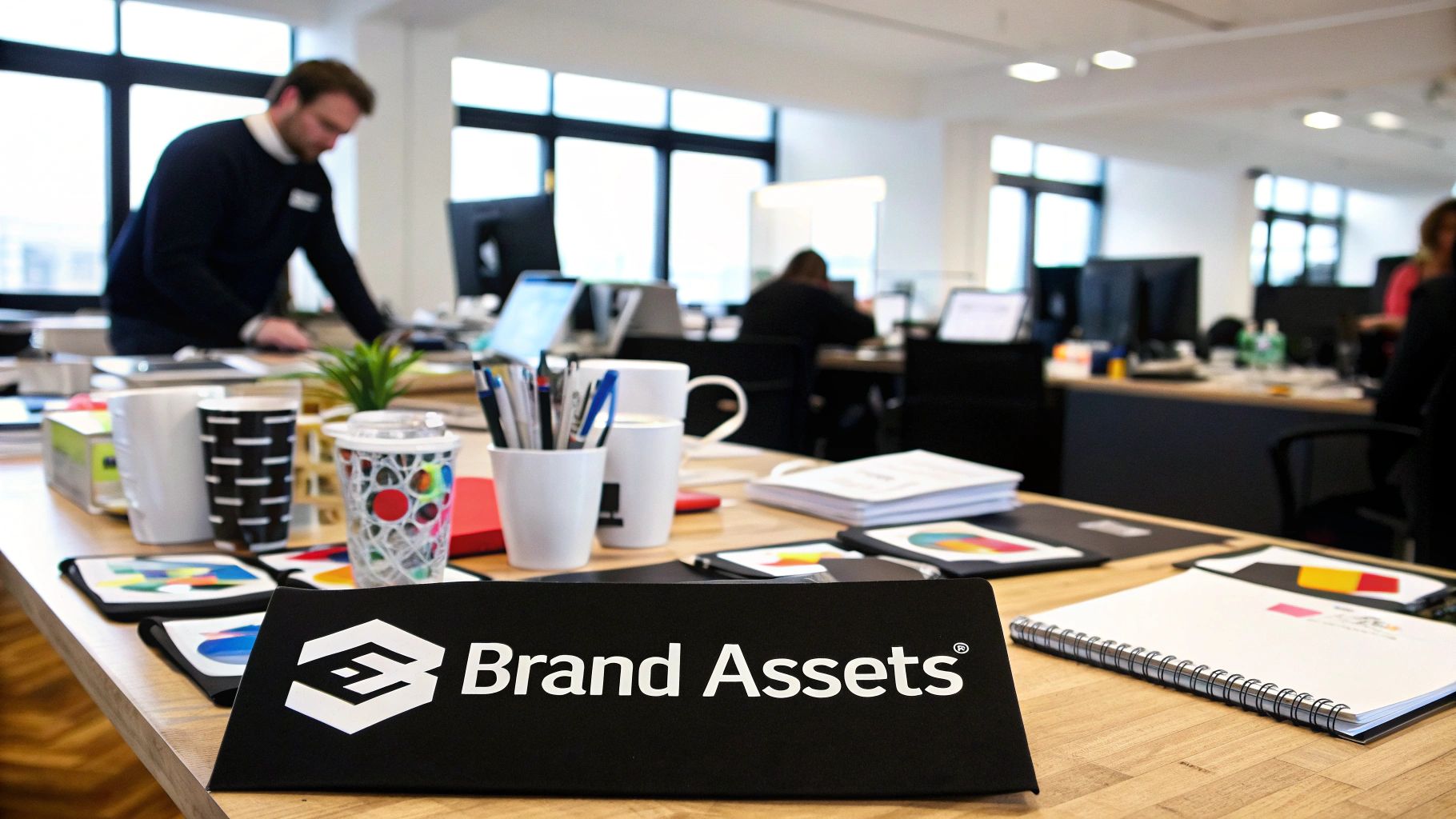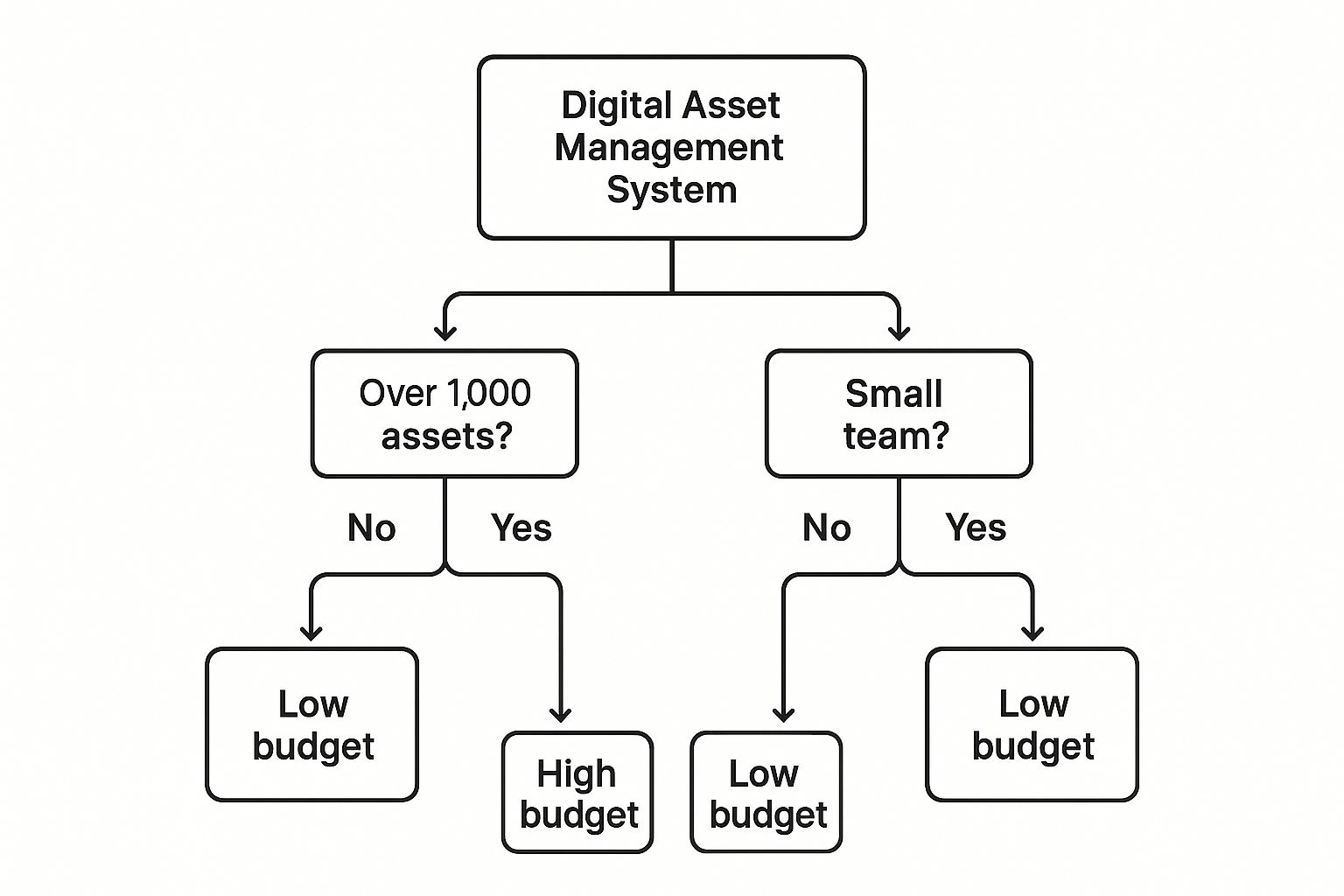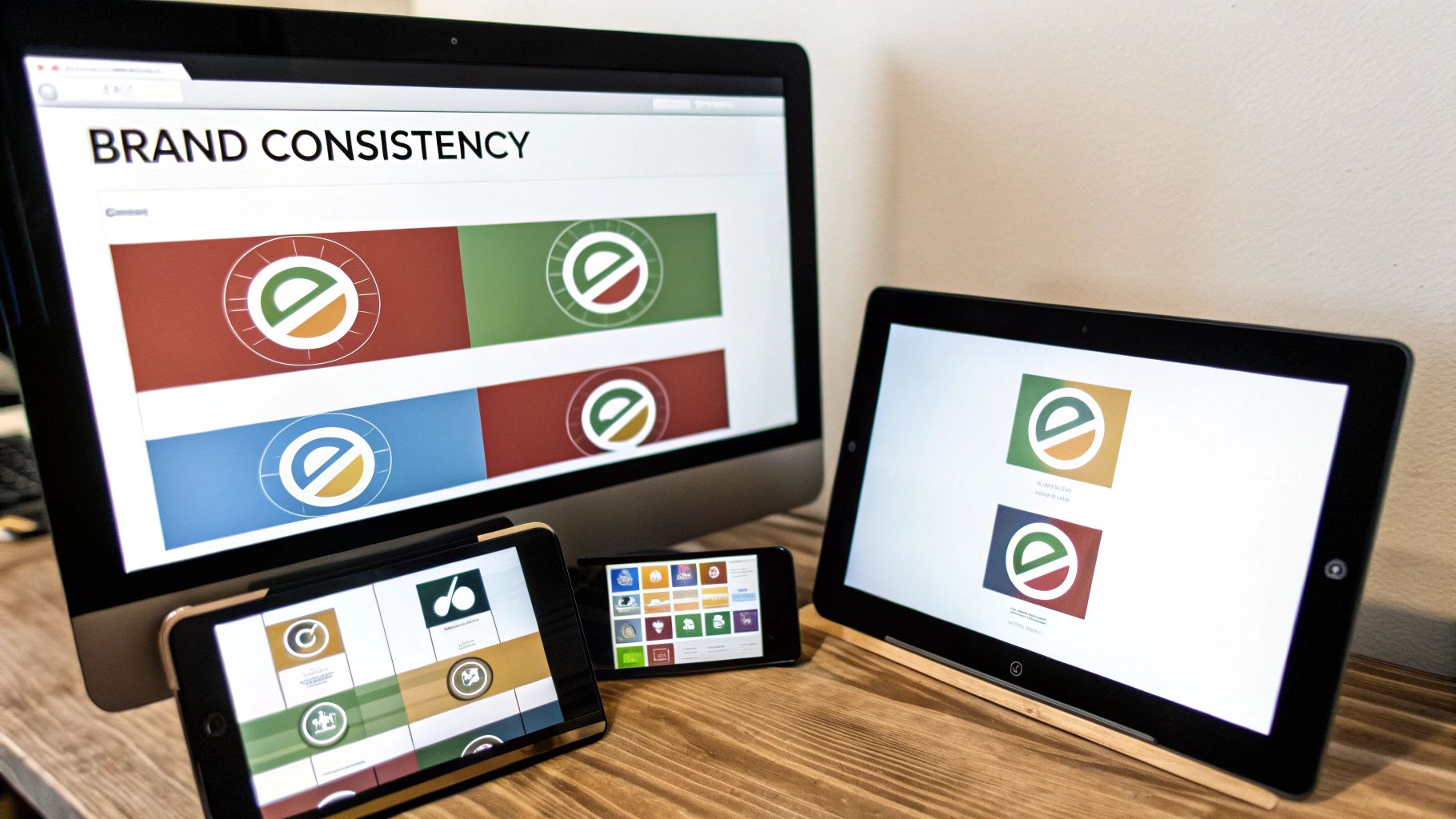It’s easy to write off asset chaos as just the cost of doing business—until it starts to punch a hole in your bottom line. I've seen it happen time and again. Brand asset management isn't just about keeping your files tidy; it's a core business function that prevents real damage, builds trust, and makes every marketing dollar count.
The Real Cost of Disorganized Brand Assets
Imagine this: a key partner sends out a major press release, but they’ve used your old logo. Or your sales team is busy sending prospects proposals with last year's outdated messaging. These aren't just minor slip-ups. They're symptoms of a disorganized system that actively chips away at brand trust and creates massive friction for your team.
When your assets are scattered across desktops, cloud drives, and old email threads, the damage is both immediate and long-term.
These version control nightmares always lead to frantic, last-minute scrambles for the 'right' file, burning through valuable time and resources. The true cost isn’t just the few minutes spent searching—it's the hundreds of hours lost across an entire organization, the missed opportunities from delayed campaigns, and the brand dilution that happens with every single inconsistent touchpoint.
The Financial and Reputational Damage
Let's be blunt: disorganization creates tangible business risks. Here are a few all-too-common scenarios I’ve seen play out:
- Wasted Marketing Spend: Running ads with the wrong branding or an outdated offer is like setting cash on fire. The campaign won't just fail to resonate; it might actively confuse potential customers.
- Legal & Compliance Headaches: Using an image without the proper license or distributing materials that violate regulatory standards can spiral into expensive legal battles. It happens more than you think.
- Eroded Brand Equity: Consistency is what builds recognition and trust. When your logos, colors, and messages are all over the map, it signals a lack of professionalism and weakens your standing in the market.
A strong brand isn't just a marketing concept; it's a financial asset. In a crowded market, a reputation for reliability and client focus can be the one thing that truly sets you apart and drives business forward.
This isn't just theory. We see this proven even in high-stakes industries like finance. A study from Broadridge Financial Solutions highlights how the world's top-performing fund brands are set apart by their solid reputations. In fact, brand strength was a key factor that allowed BlackRock to reclaim its #1 spot in the U.S., proving the immense competitive advantage of a trustworthy brand. You can dive deeper into these brand performance findings in the global report.
Visualizing the Asset Management Workflow
So, how do you fix this? It starts with a central system. This diagram shows how a Digital Asset Management (DAM) system becomes the heart of your brand—centralizing the creation, management, and distribution of every asset.

It’s a cyclical process. Assets are brought in, tagged with crucial metadata, and then made securely accessible to your teams. This ensures consistency from the moment an asset is created to the moment it reaches your audience. Without this central hub, every step in that cycle is a potential point of failure.
In today's world, a central system isn't a luxury—it's a necessity for survival and growth.
How to Conduct a Thorough Brand Asset Audit

Before you can even think about organizing your brand, you need to get painfully honest about what you actually have. A proper brand asset audit is your essential first step, and it goes way beyond just listing logos and color codes. This is a deep dive into every single piece of content that represents your company out in the world.
I'm talking about hunting down everything—presentation templates, official photography, B-roll video footage, and even the boilerplate copy hiding in forgotten shared drives and personal folders. This isn’t just spring cleaning; it’s about laying the groundwork for a scalable system for managing brand assets that can actually grow with you.
Locating Every Asset Across Your Company
Let's be real: your assets are probably scattered everywhere. The goal of this first phase is pure discovery. Don’t even worry about organization yet—just find it all.
Start by mapping out every possible place files could be hiding. This includes the usual suspects like Google Drive, Dropbox, and local servers, but you have to dig deeper. Don't forget the less obvious spots.
- Email Inboxes: Search for attachments in the accounts of key team members, especially in marketing, sales, and design. You’d be amazed what you can find.
- Project Management Tools: Platforms like Asana or Trello often have critical files attached to specific tasks or old projects.
- Third-Party Platforms: Check your social media schedulers, email marketing services (like Mailchimp), and your website’s CMS.
- Freelancer Archives: This one's huge. Reach out to past contractors who might be sitting on final files you never officially received.
As you go, create a simple inventory spreadsheet. All you need are columns for the asset name, its location (with a link, if possible), file type, and a notes section. This document becomes your roadmap. And if you're reviewing your core materials, our branding tips for small businesses can help ensure they're strong from the start.
Categorizing Assets and Making Tough Decisions
Okay, with your inventory list complete, it’s time to start making some calls. This is where you bring order to the chaos, assessing each asset against a clear set of standards. Your mission is to sort every single file into one of three buckets.
An audit isn’t just about finding what you have. It's about confidently deciding what to keep, what needs a refresh, and what should be permanently retired to prevent future misuse.
Use this simple framework to guide your decisions:
- Keep: These are the golden assets—current, on-brand, and used all the time. They’re the first ones you'll move into your new, centralized system.
- Update: The asset is still valuable, but it’s outdated. Think of a sales deck with old statistics, a video featuring a retired logo, or photography that no longer reflects your brand’s vibe. Tag these for revision.
- Archive: This is for the old, off-brand, or totally irrelevant assets. Don't delete them just yet. Instead, move them to a separate, clearly marked "Do Not Use" folder to take them out of circulation for good.
This methodical approach ensures you're building your new system on a foundation of quality, not clutter. The numbers back this up, too. The Digital Asset Management (DAM) market was valued at $3.96 billion and is projected to smash $16 billion by 2032. It's clear that getting this process right is non-negotiable for modern businesses. You can check out a full analysis on the state of digital asset management from Marcom to see just how critical this has become.
Alright, you’ve done the hard work of auditing your brand assets. Now comes the big question: where do they all live? This isn't just about finding a digital file cabinet; it's about building a single source of truth that your entire team can rely on. Picking the right central hub is one of the most important decisions you'll make for managing brand assets effectively.
Your main choices really boil down to two paths: a well-organized shared cloud drive (think Google Drive or Dropbox) or a dedicated Digital Asset Management (DAM) platform. The best fit isn't about a fancy feature list—it's about what your team actually needs based on its size, workflow, and budget.
For a small startup or a tight-knit team, a meticulously structured Google Drive can be a lifesaver. It’s cheap, and everyone already knows how to use it. But as you scale, that simple setup can quickly descend into chaos. Version control becomes a guessing game, finding the right logo feels like a scavenger hunt, and you simply don't have the sophisticated controls needed to protect your brand's integrity.
When to Upgrade to a DAM
So, when is it time to graduate? You’ll know you need a dedicated DAM like AI Media Studio when the headaches of a shared drive start costing you more in wasted time and brand mistakes than the platform itself. A DAM is purpose-built to solve these exact problems.
It's probably time to consider a DAM if you're nodding along to any of these scenarios:
- Constant file requests: Your marketing or design lead feels more like a librarian, constantly digging up logos, photos, and templates for the rest of the team.
- Version control chaos: You spot an old logo on a new sales deck or see an unapproved image pop up on social media. It happens.
- Fuzzy usage rights: You can't quickly see when a stock photo license expires, which puts your company at risk of expensive compliance issues.
- Projects are always delayed: Campaigns get stuck because key people can't find or access the files they need to get their work done.
A great Digital Asset Management system does more than just store files. It turns your asset library into an intelligent, searchable command center for your brand. It’s a direct investment in your team's efficiency and your brand's consistency.
If you're still on the fence, this chart can help clarify which path makes the most sense for your organization right now.

As the infographic shows, the more assets you have and the bigger your team gets, the more a powerful, dedicated solution like a DAM shifts from a "nice-to-have" to a "can't-live-without."
Brand Asset Storage Solutions Comparison
Choosing between a familiar tool and a specialized one can be tough. This table breaks down the core differences in capabilities that matter most for day-to-day work.
| Feature | Shared Cloud Drive (e.g., Google Drive) | Dedicated DAM Platform (e.g., AI Media Studio) |
|---|---|---|
| Smart Tagging | Manual folder organization only. Finding things depends on good naming conventions. | AI-powered and custom metadata for fast, intuitive searching. Find what you need, even if you don't know the file name. |
| User Permissions | Basic view/edit/comment access at the folder or file level. | Granular control. Decide exactly who can view, download, edit, or share specific assets or collections. |
| Version History | Tracks changes, but navigating multiple file versions can be clunky and confusing. | Clear, accessible history for every asset. Everyone is confident they're using the most current, approved version. |
| Integrations | Limited. Often requires third-party tools like Zapier to connect to your workflow. | Direct plugins for the tools your team already uses, like Figma, Adobe Creative Cloud, and your CMS. |
Ultimately, picking the right platform is a foundational step. By matching the solution to your real-world needs, you'll avoid overpaying for a system that's too complex or, worse, hamstringing a growing team with a tool they've already outgrown.
Creating a Scalable Organization System

Picking the right platform is a huge step, but the real magic happens when you build a system that everyone on your team instinctively understands. A powerful tool for managing brand assets is pointless if nobody can find what they’re looking for. A scalable system isn’t about enforcing rigid, complex rules; it’s about creating a simple, intuitive framework that anyone can pick up and run with.
It all starts with a logical folder structure that actually mirrors how your business operates. Forget those generic folders like “Images” or “Docs.” You have to think in terms of your real-world workflows. Do you organize projects by client? By quarter? By campaign? Your top-level folders should reflect that logic.
For instance, a marketing agency might build its main folders around client names. A SaaS company, on the other hand, might organize everything by product line. The goal is to make the path so obvious that a new team member could find a specific asset on their first day without having to ask for help.
Designing a Bulletproof File Naming Convention
Once your folders are in order, the next essential layer is a standardized file naming convention. This is your first line of defense against digital chaos and your secret weapon for lightning-fast searches. A great naming system gives you vital context before you even click open a file.
A simple, effective template can make a world of difference. Think about using a format like this:
CampaignName_AssetType_Variant_Date.ext
Let’s see what that looks like in action for a hypothetical summer sale campaign:
SummerSale24_SocialPost_InstagramStory_20240715.mp4SummerSale24_Logo_FullColor_20240715.pngSummerSale24_EmailHeader_V2_20240715.jpg
This structure instantly tells you everything you need to know about the file. It’s descriptive, consistent, and makes sorting a breeze.
A well-designed naming convention turns your file list into a scannable dashboard. It eliminates guesswork and drastically cuts down the time spent searching for the right version of an asset.
The Power of Metadata and Tagging
While folders and file names create the skeleton, metadata adds the muscle. This is what truly elevates your asset library from a simple storage folder into a smart, searchable database. To unlock the full power of your brand asset management system, consistent tagging is absolutely crucial.
Instead of just relying on where a file is saved, you can attach rich, searchable information directly to the asset itself. This data lives with the file, no matter where it gets moved.
- Usage Rights: Tag images with their license details (e.g.,
RoyaltyFree_Expires2025-12-31). - Target Audience: Define who the asset is for (e.g.,
Audience-NewCustomers,Audience-Enterprise). - Product Line: Connect assets to specific products (e.g.,
Product-Alpha,Product-Beta). - Content Type: Clarify the asset's purpose (e.g.,
Type-CaseStudy,Type-WebinarPromo).
With a platform like AI Media Studio, you can even use AI to automatically suggest tags based on visual content, saving a ton of time and ensuring everything stays consistent. This detailed approach is the blueprint for a system that doesn’t just store your assets—it makes them smarter, more accessible, and ready to scale right alongside your business.
Maintaining Consistency with Clear Brand Guidelines
https://www.youtube.com/embed/uH9OvlDBX4A
Getting your brand assets organized is a huge win, but let's be honest—it's only half the job. Now you have to make sure every single one of those assets is used correctly. This is where your brand guidelines stop being a static document and start being your most valuable tool for managing brand assets effectively.
The old way just doesn't cut it anymore. That dusty, 100-page PDF that no one ever reads? It’s broken. Today's brand guidelines have to be alive, accessible, and built for the fast pace of modern work. The real goal is to make following the rules easier than breaking them.
This means going way beyond just logo placement and a few color codes. Your guidelines should be the complete playbook for your brand's identity.
Building Your Modern Brand Playbook
To really be effective, your brand guidelines need to be crystal clear, straight to the point, and cover all the essentials that define how your company shows up in the world. Think of it as a living document that captures the look, feel, and voice of your brand at every single touchpoint.
Here's what absolutely needs to be in there:
- Logo Usage: Lay out clear rules for every logo variation (full color, single color), minimum display sizes, and the exact amount of clear space required around it. Don't just tell—show. Include visual examples of right and wrong.
- Color Palette: Define your primary, secondary, and accent colors with their precise hex, RGB, and CMYK values. Just as important, explain the purpose of each color to guide how and when it's used.
- Typography: Pinpoint your brand fonts for headlines, body copy, and calls to action. You'll want to include specifics on weights, sizes, and spacing to keep everything looking sharp and professional.
- Tone of Voice: This is a big one. You have to describe your brand's personality. Are you playful and informal? Authoritative and serious? Give real-world examples of how that voice translates into actual copy.
Your brand guidelines are the constitution for your brand. They empower every employee, freelancer, and partner to become a confident brand guardian, ensuring a cohesive and professional experience for your customers.
To make sure these rules actually get followed, you have to weave them into your team's everyday workflow. Embed them directly within your DAM system, create quick-reference cheat sheets, and maybe even produce short, engaging training videos. You can dive deeper into this topic in our guide to creating effective visual brand guidelines for consistent branding.
The Financial Impact of Brand Strength
All this work to maintain consistency isn't just about looking good; it's about building serious, tangible value. A strong, unified brand is an absolute game-changer in competitive markets, especially in a field like finance.
Globally, total assets under management (AUM) are expected to reach an incredible $145.4 trillion. But here's the kicker: the top 20 firms in the U.S. control about 85% of that wealth. In a market that concentrated, brand strength is a key differentiator that helps protect and grow market share. It’s a clear line connecting how well you manage your brand assets to your company's bottom line.
Common Questions About Managing Brand Assets
As teams finally get serious about organizing their brand assets, a few practical questions almost always bubble up. It's one thing to talk about a clean, organized system in theory, but it's another thing entirely to deal with the messy, real-world problems that crop up day-to-day. Let's tackle some of the most common ones I hear.
Getting these answers right helps turn abstract ideas into concrete actions. From handling freelancers to knowing when it's time for a real tool, these insights will help you sidestep the usual hurdles on the path to brand consistency.
How Should We Handle Freelancer and Agency Access?
This is a big one. Granting access to outside partners without losing control of your assets is a major source of anxiety for brand managers. You don't want a contractor going rogue with unapproved files or a former agency holding your critical assets hostage.
The solution is to stop emailing zip files and giving wide-open access to a shared drive. Instead, you need a system with granular user permissions.
- Create dedicated project folders: For each project, set up a specific collection with only the assets that freelancer or agency actually needs. Nothing more, nothing less.
- Set clear permissions: Let them view or download files, but lock down their ability to edit or delete the originals.
- Use expiration dates: This is critical. You can set access to automatically expire the day a project wraps or a contract ends. No more manual cleanup.
This simple shift changes the entire dynamic. It replaces chaotic handoffs with a secure, controlled workflow, giving partners what they need while protecting the integrity of your core brand library.
When Is It Time to Upgrade from a Shared Drive?
A shared drive is where most teams start, but at a certain point, it becomes more of a liability than a help. You'll know it's time to upgrade to a proper Digital Asset Management (DAM) system when the daily friction costs you more in time and mistakes than the software itself would.
Look out for these classic warning signs.
The biggest red flag is when your marketing or creative lead starts spending more time as a file librarian than doing their actual job. If they’re constantly fielding Slack messages asking "where's the new logo?", your system is broken.
Other telltale signs? Frequent version control errors—like that old logo popping up on a new sales deck—or the frantic scramble to verify usage rights for a stock photo you need right now. When these problems go from being occasional annoyances to a regular part of your week, it's time to invest.
With research showing that 65% of employees need to use branded materials weekly, making those assets easy and reliable to find is a huge lever for company-wide efficiency.
Ready to stop the file chaos and build a true command center for your brand? AI Media Studio gives you the powerful tools you need to organize, control, and distribute your assets with confidence. Experience the difference a dedicated system can make by exploring our platform today.